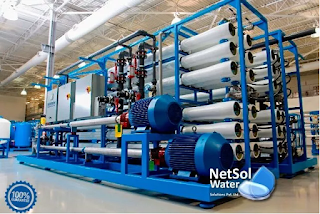How does temperature and pressure affect the performance of an industrial RO systems?
Due to ignorance of the detrimental effects of too cold or too hot water on the functioning of their reverse osmosis (RO) systems, hundreds of dollars are lost every year on unnecessary membrane repairs. Typically, people assume that their membranes are contaminated when, in reality, the temperature of the feed water has only fallen, greatly reducing the membrane output.
RO filters work differently depending on a
variety of conditions. These variables may often be split into two categories:
feedwater properties and system design. Different feedwater can alter a RO
filter's flow and rejection. The feedwater's temperature, pressure, and salt
content should all be taken into account.
Temperature:
The flow of RO
permeate is significantly influenced by the operating temperature. The permeate
flow rises as water temperature rises. This occurs because at higher
temperatures, water has less viscosity and a faster diffusion rate, making it easier
for the water to move through the RO membrane. According to a common rule of
thumb, the permeate flow rises by 3% for every 1° C increase in temperature.
The majority of membrane suppliers include temperature adjustment tables, which
enable more precise conversions.
Temperature affects
not just how much water is created but also how much salt may travel through
the membrane. The membrane of RO becomes hotter due to the warmer feedwater,
which speeds up the process of salt dilution. According to the usual rule of
thumb, salt passage grows by 6% for every 1° C rise in feedwater temperature,
or twice as much as the growth in water flow. As a result, residential
point-of-use (POU) systems will have larger flows and worse rejection in the
summer and lower flows and better rejection in the winter when there are
significant seasonal variations in feedwater temperature.
Pressure
One must first think
about the idea of net driving pressure in order to comprehend the effects of
altering the feed pressure on a RO filter (NDP). The total of all forces
operating on the membrane is the NDP. Pump or feed pressure, back pressure from
line constraints and storage tanks, and osmotic pressure of the feed and
permeate water are a few of these that may be present.
Assume that the yellow
pump in below is applying 150 psi of pressure to water that is on one side of a
RO membrane and has a total dissolved solids (TDS) concentration of 1,000 mg/L.
Assume the water has a TDS of 0 mg/L on the other side of the RO membrane. Assume
the water has a TDS of 0 mg/L on the other side of the RO membrane. One must
add up all of the forces operating on the membrane in order to calculate the
NDP.
TDS must first be
converted into psi. As a general rule of thumb, multiply the TDS in ppm by 100 to
obtain the water's osmotic pressure in psi. Divide the result by 1,400 to get
the osmotic pressure in bars. The osmotic pressure of water with a TDS of 1,000
ppm is approximately 10 psi, or 0.7 bar.
Using the
aforementioned example, one can determine the net driving pressure as follows:
NDP = Feed pressure –
feed osmotic pressure + permeate osmotic pressure
NDP = 150 psi – 10 psi
+ 0 psi
NDP = 140 psi
NDP is the actual
pressure that the membrane experiences while it is in operation. The permeate
flow will double if the net driving pressure to a RO unit is doubled.
Clean water goes
through the membrane when the feedwater passes through the RO filter. This
raises the concentration in the feedwater, which raises the TDS of the
feedwater. As a result, the TDS of the intake feed is always lower than the TDS
of output concentrate. Similar to this,
some feed pressure drop occurs as a result of friction when water flow goes
through the filter and vessel. As a result, the pressures at the input and
output are never equal.
Why Netsol Water
Solutions?
We are the leading
producer and supplier of industrial RO systems in India. The industrial water
filtration system works best in a simple, mostly industrial environment. We
offer the best industrial RO plants to meet our clients' demands.
Our system is
exceptionally cost-effective and reliable for use in an industrial environment.
We work with each of our clients to give high-quality filtration systems at
affordable pricing since we, as a commercial manufacturer, are aware that you
need the best systems available, at fair and competitive prices.
Contact us at enquiry@netsolwater.com or by phone at +91-9650608473
for any more assistance, questions, or product orders.

Comments
Post a Comment